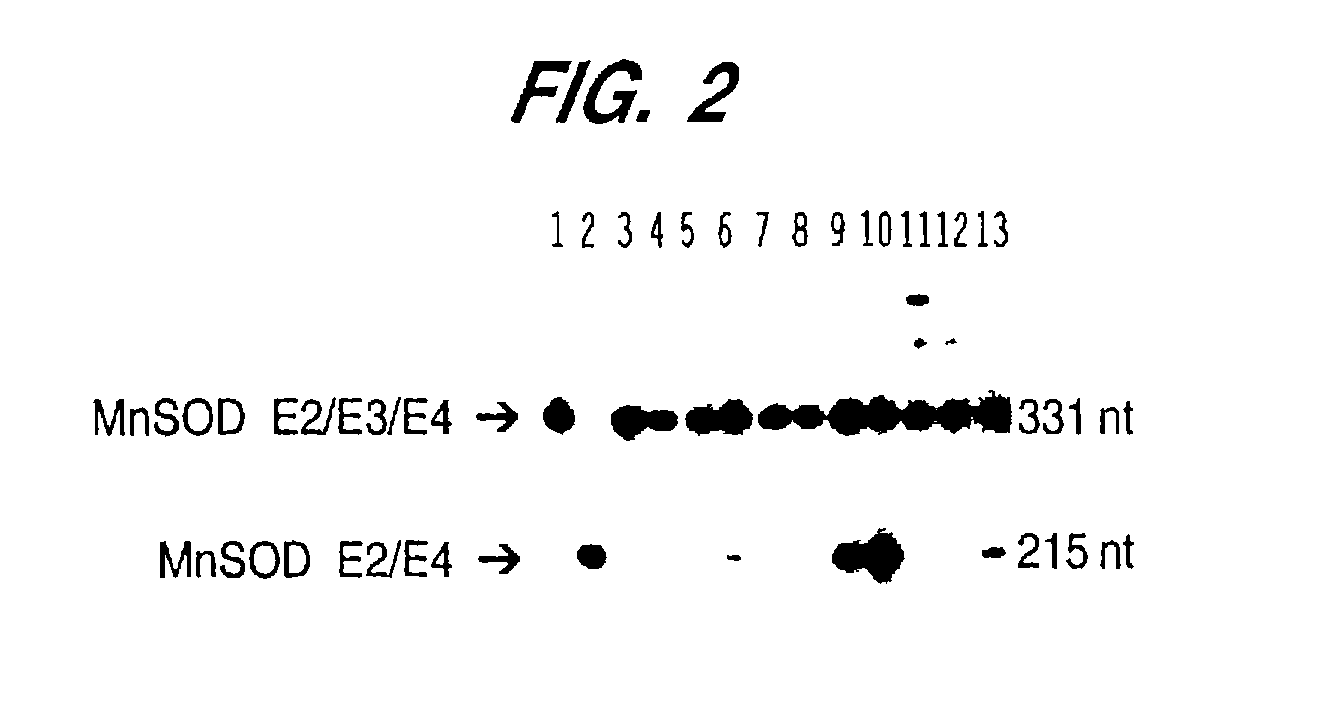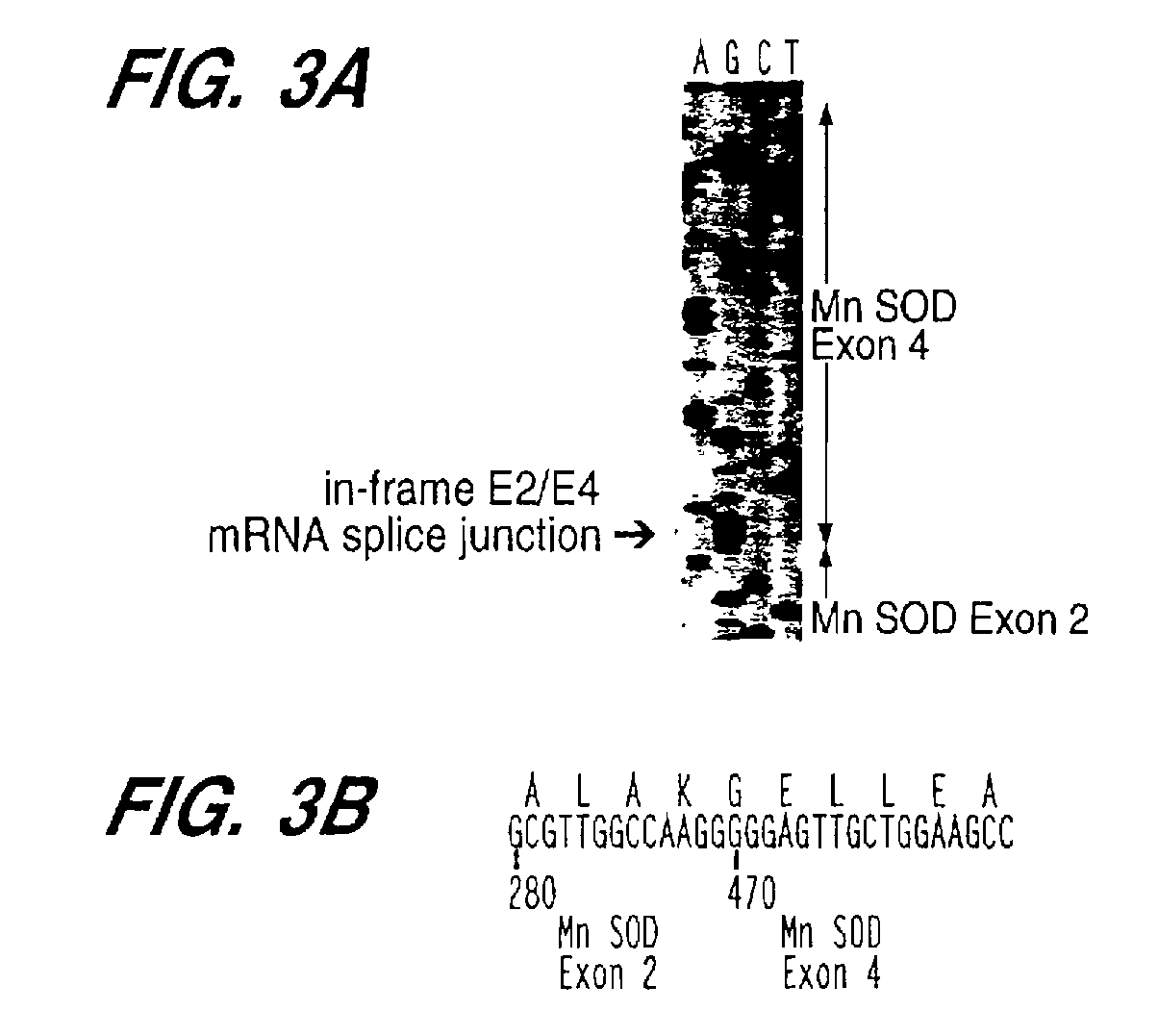Manganese superoxide dismutase exon 3-deleted isoforms and nucleic acid molecules encoding the isoforms
a technology of manganese superoxide dismutase and exon 3 isoform, which is applied in the direction of enzymology, organic chemistry, peptide/protein ingredients, etc., can solve the problems of oxidative damage to a wide variety of macromolecules and cellular components, protein and lipid peroxidation, and oxidative damage to the mtdna
- Summary
- Abstract
- Description
- Claims
- Application Information
AI Technical Summary
Benefits of technology
Problems solved by technology
Method used
Image
Examples
example 2
In vitro Expression of the cDNA of the MnSOD E3(−) Splice Variant and its Effect on mtDNA and Nuclear DNA Degradation
[0123]The effect on the genomic structure of cellular DNA by expression of the cDNA encoding the E3(−) MnSOD isoform was examined using the tet-off mammalian gene expression system (Clontech).
[0124]Transient transfection of HEK293 tet-off cells with the full length, antioxidant-MnSOD or the MnSOD E3(−) cDNA are shown in FIGS. 5A and 5B. Both cDNAs are driven by the tetracycline / doxycycline-regulated transcription factor (Clontech). HEK293 tet-off cells were grown in DMEM / 5%FBS with 20 ng / ml doxycycline and then electroporated with 1 mg recombinant plasmid per 108 cells. Electroporated cells were split into four 60mm plates and grown for 30 hrs in the same medium. The medium in each plate was replaced with DMEM / 5% FBS with either 20 ng / ml, 2.0 ng / ml, 0.2 ng / ml, 0.02 ng / ml doxycycline. Cell growth was continued for 24 hours to allow expression of the transfected cDNA. T...
example 3
Preparation and Use of Polyclonal Antiserum Containing Anti-MnSOD E3(−) Antibodies
Antibody Preparation
[0130]A polyclonal antibody was raised in rabbits using the peptide sequence: NH2-(GlyCys)-GlnGluAlaLeuAlaLysGlyGluLeuLeuGluAla (vendor: BioSynthesis, Inc. Project #: BSYN 617,618. The N-terminal GlyCys are not MnSOD-encoded sequence, and are part of this peptide sequence for technical reasons).
[0131]Antibodies were prepared according to the following protocol:
[0132]The animals used were two New Zealand White Females, approximately 12 weeks of age, 2 kg of weight. Two (2) antigen-adjuvants compositions were used. For primary injection, (1:1) 200 ug of conjugated peptide (˜0.5 ml of conjugate solution) plus equal amount of Freund's complete adjuvant was used. For booster injection, (1:1) 200 ug of conjugated peptide (˜0.5 ml of conjugate solution) plus equal amount of Freund's incomplete adjuvant was used. Animals were inoculated according the following schedule:
AMOUNTS / VOLUMESDAYPRO...
example 4
Isolation and Use of Nucleic Acids
[0140]RNA and DNA Preparation and mtDNA Detection
[0141]Total cellular RNA was prepared from peripheral mononuclear blood cells (PMBCs) as follows. 10 mls of blood were drawn in a purple-top, EDTA vacutainer tube, diluted twofold with HANK's 1× buffer, and banded on a Percoll-Plus gradient according to manufacturer's direction (Pharmacia). Cells were continually maintained in serum during isolation. Cells were pelleted and quickly lysed with 2 ml of Trizol (GIBCO / BRL). After 5 min at room temperature, the lysed solution was mixed with 0.2 vol of chloroform, mixed and microfuged for 10 min. The aqueous phase was removed and 0.6 vol of isopropanol was added, mixed and total ribonucleic acids were precipitated at room temperature for 15 min. RNA was pelleted by microcentrifugation for 10 min, and the pellet was resuspended in 0.5 ml of water. This solution was then extracted with acidic phenol (Ambion). RNA was precipitated by adding one-tenth volume of...
PUM
 Login to View More
Login to View More Abstract
Description
Claims
Application Information
 Login to View More
Login to View More - R&D
- Intellectual Property
- Life Sciences
- Materials
- Tech Scout
- Unparalleled Data Quality
- Higher Quality Content
- 60% Fewer Hallucinations
Browse by: Latest US Patents, China's latest patents, Technical Efficacy Thesaurus, Application Domain, Technology Topic, Popular Technical Reports.
© 2025 PatSnap. All rights reserved.Legal|Privacy policy|Modern Slavery Act Transparency Statement|Sitemap|About US| Contact US: help@patsnap.com



